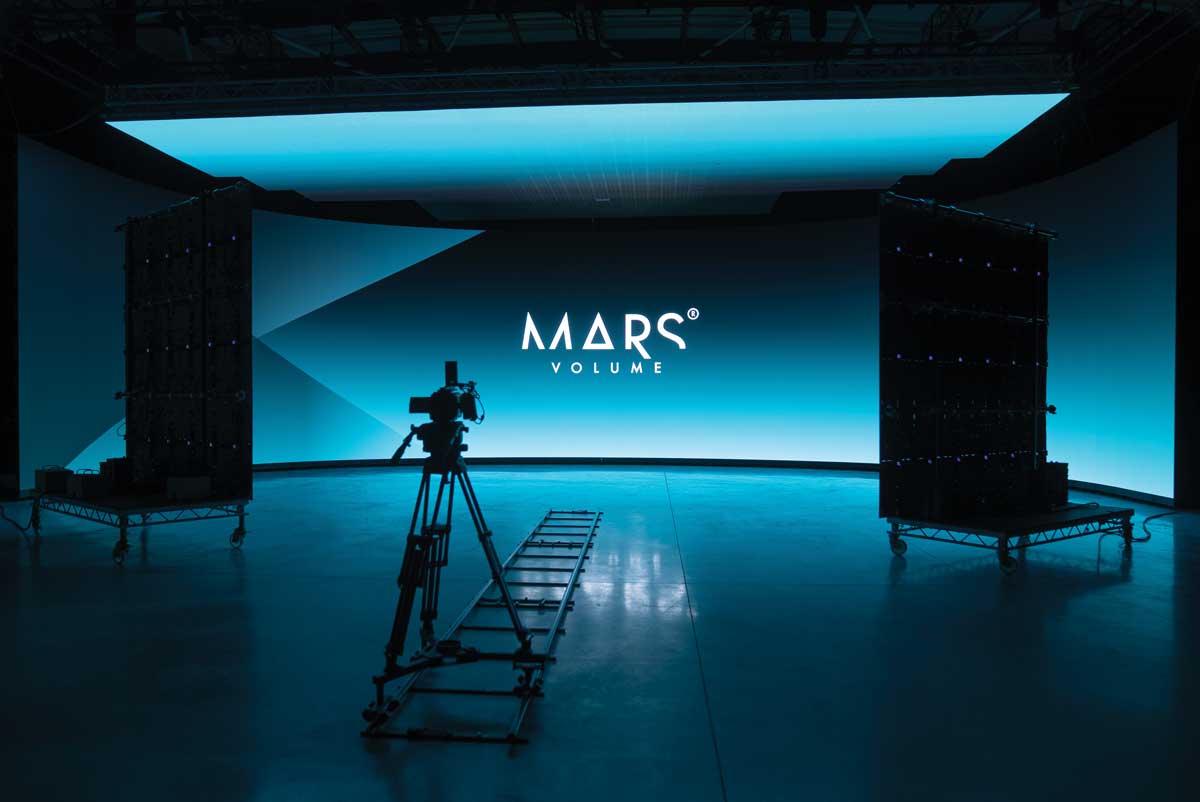
Shooting Sustainably in a Volume
Posted on Oct 29, 2024 by Samara Husbands
As well as opening up creative possibilities, virtual production offers a way to significantly reduce a shoot’s environmental impact
Words Adrian Pennington
One of the chief motivations for productions to be based locally in a volume is the reduction in polluting international air and road travel for dozens of crew members. The BFI and Disruptive LIVE have attributed more than half of total CO2 emissions from blockbuster film productions to transportation. Using an LED volume to change set locations can significantly reduce the carbon footprint, according to Ben Lumsden, executive producer, Dimension Studio and DNEG 360.
“There is a growing awareness of addressing these issues and, as virtual production technologies mature, we can expect these developments to be further integrated into workflows,” he comments.
“When we first opened, we saw a lot of productions state that sustainability was important to them. However, in reality, it took quite a secondary role,” explains Joanna Alpe, chief commercial officer at MARS Volume. “In recent months, we’ve seen a shift in this approach.”
She attributes this to agencies taking bold moves such as banning travel for productions, producers requiring specific measurements of power usage for the shoot to generate environmental reports and a real increase in productions shooting in VP to replicate multiple locations around the world. “Data suggests the tide has turned, and this provides a perfect opportunity for VP and ICVFX to shine as sustainable options for reducing carbon emissions in film and TV production,” she says.
Cutting down on travel is the biggest win for sustainability, but more can be done. VP also streamlines the production process, allowing for creative decisions to be made on-set, which reduces the need for reshoots. Alpe states: “Clever use of minimal props and highly skilled virtual art departments create believable scenes and sets, where it’s nearly impossible to distinguish where the physical art department ends and the virtual takes over. By reducing the reliance on large-scale set builds (which ultimately get torn down and create a disposal issue), carbon emissions per shoot can be massively reduced.”
The LiveStitch system, designed and developed by CineArray, offers several ways to reduce emissions. The system provides a live stitched image of every camera feed from an array and records this onto a removable SSD.
Laura Tinsley, operations manager at CineAero, says the system is a first of its kind. She explains: “Previously, all footage would have to be sent with a driver, then immense processing power and servers were used to stitch and store the images before even being able to view daily footage. The LiveStitch system removes this step and means stitched preview footage can be sent securely via a laptop for review.
“A unique way that LiveStitch further reduces the need for being on a set is its ability to provide a fully stitched live feed of the array from anywhere in the world. The LiveStitch has its own built-in uplink, allowing a whole VFX team at a studio to view a live feed and provide commentary. Only a skeleton crew needs to work at the location, which reduces emissions across the board.”
Reducing the reliance on post-production workflows is another gain for sustainability. “By capturing VFX mostly in-camera, the post-production workflow is reduced and sometimes eliminated altogether,” points out Alpe. Current post-production workflows rely upon huge render farms working 24/7, requiring significant energy supplies. Some reports suggest there could
be as much as a 30% reduction in shooting final-pixel VP versus green screen and post-production workflows.
Research by Filmakademie Baden-Württemberg and IFC on behalf of Sony has shown that the carbon emissions savings of VP go beyond travel and accommodation. As much as a 60 to 80% reduction in energy consumption has been recorded within like-for-like productions comparing VP with offline-rendered productions.
The largest savings result from spending less time on post-production, fewer shooting days and reduced waste. Using renewable energy can further reduce the carbon emissions of the energy consumed.
According to AdGreen, the average commercial generates ten tonnes of carbon. Since the majority of the 100 productions hosted at Garden Studios have been commercials, Julie Hoegh, head of sustainability, comments that in-studio shooting has resulted in net carbon savings of roughly 600 to 800 tonnes. “This shows real potential.”
She says that the advertising side of the industry is pushing VP more than any other. This is, in part, because the entirety of a commercial can be shot in volume and also because of AdGreen’s initiative to help productions be less wasteful.
“Sustainability is now taken as a serious consideration for ad productions,” she notes. “We’re seeing slower traction in TV and film, likely due to issues with the scale of their production, and because cost and efficiency are being prioritised.”
Measuring up the issue
There are still some unknowns around the sustainability of VP. For example, no one has yet undertaken a life cycle analysis of LED volumes. “We also don’t fully understand the carbon impact of extensive data storage, rendering and cloud computing,” says Hoegh. “Furthermore, the lifespan of LED walls and the ability to update existing walls will be crucial in maintaining the sustainability of VP, as well as how frequently they are being used.”
The use of VP aims to reduce the amount of crew travelling to a given location. Definition wondered whether an equivalent number of crew members would still be required on-site and if this would impact sustainability.
“Imagine filming a large crowd scene set in ancient Egypt,” responds Lumsden. “A traditional shoot would require a large number of people on location. In contrast, the number of people required for the ICVFX version of this would be far smaller than filming it all for real. For a successful VP shoot, you must tie in real physical elements, therefore you always need a traditional crew. However, the physical crowds and scale of on-location shooting are reduced, contributing to a more sustainable production,” he describes.

Global Sustainability Standards
While there is a Studio Sustainability Standard delivered by BAFTA albert (with technical partner Arup), there are differences in how sustainability is measured and accounted for from country to country.
For example, the benefit of choosing VP varies depending on the fuel mix of the grid. A VP in Sweden will be more sustainable than an identical one in Poland or Romania, for instance, due to the higher proportion of renewables on the grid in Sweden.
“I believe BAFTA albert is working on ways to create a carbon calculator for VP, and that’s something we would welcome,” highlights Hoegh. “Carbon calculators, sustainability certifications and other frameworks and tools are being worked on by organisations like albert and the Producers Guild of America,” she adds. “These standards must consider the entire life cycle of production equipment.”
Dimension says it carefully tracks employee travel and carbon consumption. The company has partnered with Treeapp and, since working together, it has planted 12,330 trees, absorbed 2279 tonnes of CO2 and reforested 2.47 hectares of land.
Alpe thinks there is exciting potential for a global standard that encourages productions to consider the sustainability benefits of VP: “I see this as being a compelling report to put in front of directors, clients and brands to gain internal buy-in and champion the sustainability gains available when utilising VP as a solid part of the production mix. By producing quantifiable numbers, this would make the case for VP over other methods (location shooting, green screen, post-production-heavy workflows) that would be hard to ignore.”
Having reliable third-party calculators that enable producers to understand the impact of various production methods would help them make informed decisions on scheduling and running their productions.
Looking ahead, more research is needed to fully understand the carbon costs associated with the manufacture and disposal of LED panels. There are also calls for more funding for recycling and reuse of digital assets.
“Training for producers and crew is the best way to drive awareness of the potential positive impact of VP,” says Hoegh. “Previs and techvis could be utilised alongside a carbon calculator to demonstrate how the time and efficiency savings could translate into greener production.”
Garden Studios actively donates props and set materials for reuse. The organisation recognises that – since one of the goals of VP is to reduce sets and props – the overall impact may be limited, but there are still items that could benefit from a new life. Hoegh would love to see consistent engagement with the donation programme. “We’re here to make the process easier and more efficient, as we know how stressful strike time can be,” she concludes.
This feature was first publishing in the November 2024 issue of Definition.










